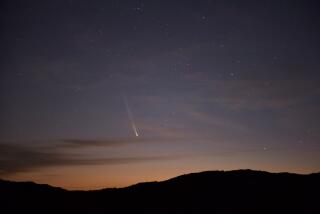SCIENCE / MEDICINE : Comet Austin May Give the Show That Halley Didn’t
- Share via
A newly discovered comet is streaking toward the sun and could become the brightest comet in more than a decade.
If it lives up to expectations, Comet Austin could make up for some of the disappointment left over from the lackluster performance of Halley’s Comet in 1986.
“It’s brightening rapidly,” said Stephen Edberg of the Jet Propulsion Laboratory, who coordinated amateur observations for the International Halley Watch.
The comet, discovered Dec. 6 by New Zealand amateur astronomer Rodney Austin, is almost impossible to see now except by experienced observers who are familiar with sky charts, but it should continue to brighten as it speeds toward the sun.
The best viewing, according to Sky and Telescope magazine, will be in late April and the first week of May, when the comet should be clearly visible just before dawn in the eastern sky. But, of course, comets do not always behave the way they are expected to.
Astronomers believe Comet Austin will be quite bright because it was 230 million miles away from the sun when it was discovered. Solar radiation reaching the comet that far away would have been very weak, so Austin is probably a very large comet to have been seen at such a great distance.
There is always the chance, however, that the comet’s brightness just suddenly flared up, leading astronomers to think it is bigger than it really is. Only time will tell.
In the weeks ahead, solar radiation will beat upon the comet, which is mostly ice, causing some of its surface to boil off and form a tail millions of miles long. In early April the comet will pass 32 million miles from the sun, close enough that sunlight striking its surface will be eight times more intense than it is on Earth.
That should make the comet much easier to see as it hangs in the sky with its tail pointed up and away from the sun. A comet’s tail always points away from the sun because it is swept back by the solar winds.
Around May 25 the comet will make its closest approach to Earth, passing within 23 million miles. But that does not mean it will be brighter. It will actually be a little more faint because it will be speeding away from the sun, heading back toward the outer solar system.
Observers will need a dark sky to view the comet, so they will have to travel beyond the bright lights of the city.
The last comet to put on a bright celestial show was Comet West in 1976. The most famous comet of all, Halley, drew a mixed reaction from most who saw it four years ago. At best it never amounted to anything but a dim patch of fuzz in the sky. But for many, it was a once-in-a-lifetime opportunity to see a comet that appears only every 76 years.
“I’m anxiously waiting,” Edberg said. So far, however, there has been no attempt to organize an official welcoming party like the one that greeted Halley, he added.
If Austin continues to look promising, it is likely that many observing programs will be set up in the weeks ahead.






